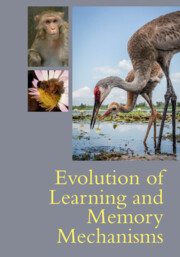Book contents
- Evolution of Learning and Memory Mechanisms
- Evolution of Learning and Memory Mechanisms
- Copyright page
- Contents
- Figures
- Tables
- Contributors
- Preface
- Introduction
- Part I Evolution of Learning Processes
- Part II Evolution of Memory Processes
- 16 The Evolution of Memory as an Immediate Perceptual Identification Mechanism
- 17 Episodic Memory in Animals
- 18 Evolutionary Origins of Complex Cognition
- 19 Evolution of Memory Systems in Animals
- 20 What Laboratory and Field Approaches Bring to Bear for Understanding the Evolution of Ursid Cognition
- 21 Distinguishing Mechanisms of Behavioral Inhibition and Self-control
- 22 Metacognitive Monitoring and Control in Monkeys
- 23 Adaptive Memory
- 24 Remembering Cheaters
- 25 Development of Memory Circuits under Epigenetic Regulation
- 26 Constraints on Learning and Memory
- Index
- References
25 - Development of Memory Circuits under Epigenetic Regulation
from Part II - Evolution of Memory Processes
Published online by Cambridge University Press: 26 May 2022
- Evolution of Learning and Memory Mechanisms
- Evolution of Learning and Memory Mechanisms
- Copyright page
- Contents
- Figures
- Tables
- Contributors
- Preface
- Introduction
- Part I Evolution of Learning Processes
- Part II Evolution of Memory Processes
- 16 The Evolution of Memory as an Immediate Perceptual Identification Mechanism
- 17 Episodic Memory in Animals
- 18 Evolutionary Origins of Complex Cognition
- 19 Evolution of Memory Systems in Animals
- 20 What Laboratory and Field Approaches Bring to Bear for Understanding the Evolution of Ursid Cognition
- 21 Distinguishing Mechanisms of Behavioral Inhibition and Self-control
- 22 Metacognitive Monitoring and Control in Monkeys
- 23 Adaptive Memory
- 24 Remembering Cheaters
- 25 Development of Memory Circuits under Epigenetic Regulation
- 26 Constraints on Learning and Memory
- Index
- References
Summary
Memory is encoded in the neuronal circuit, which undergoes continuous development driven by everyday experiences. While synaptic plasticity allows the experience-dependent modifications of the existing circuit, another essential issue is to keep the existing memory stable while simultaneously facilitating new memory formation for the novel experiences. Apparently, epigenetic regulatory mechanisms are involved in such regulation. Memory engram neurons in the brain are the hubs of the memory circuit and provide the cellular representation of specific memories. The cellular mechanisms, including epigenetic regulators, thus govern the development of neuronal circuits to store the information. Various epigenetic regulators control the landscape of information storage in the neural network in a temporal-spatial-specific manner, but regulating molecules do not code the specific content of the information. The main effects of epigenetic regulation include the gating mechanism and the stabilization mechanism to alter the ability of subneuronal networks to encode new information and preserve stored information in the memory circuit during the experience-dependent development of the brain network.
- Type
- Chapter
- Information
- Evolution of Learning and Memory Mechanisms , pp. 438 - 453Publisher: Cambridge University PressPrint publication year: 2022



